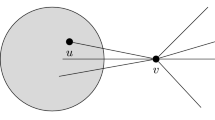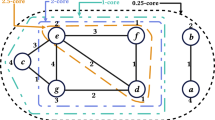Abstract
We consider optimization problems of identifying critical nodes in coupled interdependent networks, that is, choosing a subset of nodes whose deletion causes the maximum network fragmentation (quantified by an appropriate metric) in the presence of deterministic or probabilistic cascading failure propagations. We use two commonly considered network fragmentation metrics: total number of disabled nodes and total number of disabled pair-wise connectivities. First, we discuss computational complexity issues and develop linear mixed integer programming (MIP) formulations for the corresponding optimization problems in the deterministic case. We then extend these problems to the case with probabilistic failure propagations using Conditional Value-at-Risk measure. We develop a scenario-based linear MIP model and propose an exact Markov chain-based algorithm to solve these problems. Finally, we perform a series of computational experiments on synthetic and semi-synthetic networks and discuss some interesting insights that illustrate the properties of the proposed models.









Similar content being viewed by others
Notes
In this subsection only, the parameter p is used in the context of the classical G(n, p) model, rather than the parameter denoting the probability of failure propagation throughout other sections of the paper.
References
Amin, M.: Toward secure and resilient interdependent infrastructures. J. Infrastruct. Syst. 8, 67 (2002)
Arulselvan, A., Commander, C., Elefteriadou, L., Pardalos, P.: Detecting critical nodes in sparse graphs. Comput. Oper. Res. 36(7), 2193–2200 (2009)
Badanidiyuru, A., Kleinberg, R., Lee, H.: Approximating low-dimensional coverage problems. In: Proceedings of the 2012 Symposuim on Computational Geometry, pp. 161–170. ACM (2012)
Bak, P., Chen, K., Tang, C.: A forest-fire model and some thoughts on turbulence. Phys. Lett. A 147(5–6), 297–300 (1990)
Barrett, C., Beckman, R., Channakeshava, K., Huang, F., Kumar, V., Marathe, A., Marathe, M., Pei, G.: Cascading failures in multiple infrastructures: from transportation to communication network. In: 2010 5th International Conference on Critical Infrastructure (CRIS), pp. 1–8 (2010). https://doi.org/10.1109/CRIS.2010.5617569
Bienstock, D.: Optimal control of cascading power grid failures. In: 2011 50th IEEE Conference on Decision and Control and European Control Conference (CDC-ECC), pp. 2166–2173 (2011). https://doi.org/10.1109/CDC.2011.6160415
Brummitt, C.D., DSouza, R.M., Leicht, E.: Suppressing cascades of load in interdependent networks. Proc. Natl. Acad. Sci. 109(12), E680–E689 (2012)
Buldyrev, S., Parshani, R., Paul, G., Stanley, H., Havlin, S.: Catastrophic cascade of failures in interdependent networks. Nature 464(7291), 1025–1028 (2010)
Buldyrev, S.V., Shere, N.W., Cwilich, G.A.: Interdependent networks with identical degrees of mutually dependent nodes. Phys. Rev. E 83(1), 016112 (2011)
Carreras, B.A., Newman, D.E., Gradney, P., Lynch, V.E., Dobson, I.: interdependent risk in interacting infrastructure systems. In: 40th Annual Hawaii International Conference on System Sciences, 2007. HICSS 2007, pp. 112–112. IEEE (2007)
Di Summa, M., Grosso, A., Locatelli, M.: Branch and cut algorithms for detecting critical nodes in undirected graphs. Comput. Optim. Appl. 53(3), 649–680 (2012)
Dinh, T.N., Thai, M.T.: Precise structural vulnerability assessment via mathematical programming. In: Military Communications Conference, 2011-MILCOM 2011, pp. 1351–1356. IEEE (2011)
Dong, G., Gao, J., Du, R., Tian, L., Stanley, H.E., Havlin, S.: Robustness of network of networks under targeted attack. Phys. Rev. E 87, 052804 (2013)
Drossel, B., Schwabl, F.: Forest-fire model with immune trees. Phys. A Stat. Mech. Appl. 199(2), 183–197 (1993)
Dueñas-Osorio, L., Craig, J., Goodno, B.: Probabilistic response of interdependent infrastructure networks. In: 2nd Annual Meeting of the Asian-Pacific Network of Centers for Earthquake Engineering Research (ANCER). Honolulu, Hawaii, July pp. 28–30 (2004)
Dueñas-Osorio, L., Craig, J., Goodno, B., Bostrom, A.: Interdependent response of networked systems. J. Infrastruct. Syst. 13, 185 (2007)
Dueñas-Osorio, L., Craig, J.I., Goodno, B.J.: Seismic response of critical interdependent networks. Earthq. Eng. Struct. Dyn. 36(2), 285–306 (2007). https://doi.org/10.1002/eqe.626
Erdős, P., Rényi, A.: On random graphs. Publ. Math. Debr. 6, 290–297 (1959)
\(\text{FICO}^{{\rm TM}}\) Xpress Optimization Suite 7.6. http://www.fico.com/ (2013)
Gao, C., Li, X., Zhang, X., Li, K.: Network immunization for interdependent networks. J. Comput. Inf. Syst. 9(16), 6661–6668 (2013)
Gao, J., Buldyrev, S.V., Havlin, S., Stanley, H.E.: Robustness of a network of networks. Phys. Rev. Lett. 107, 195701 (2011). https://doi.org/10.1103/PhysRevLett.107.195701
Gao, J., Buldyrev, S.V., Stanley, H.E., Havlin, S.: Networks formed from interdependent networks. Nat. Phys. 8(1), 40–48 (2011)
Garey, M., Johnson, D.: Computers and Intractability: A Guide to the Theory of NP-Completeness. Freeman and Co., New York (1979)
Gong, J., Mitchell, J.E., Krishnamurthy, A., Wallace, W.A.: An Interdependent Layered Network Model for a Resilient Supply Chain. Omega 46, 104–116 (2013)
Huang, X., Gao, J., Buldyrev, S., Havlin, S., Stanley, H.: Robustness of interdependent networks under targeted attack. Phys. Rev. E 83(6), 065101 (2011)
Johansson, J., Hassel, H.: An approach for modelling interdependent infrastructures in the context of vulnerability analysis. Reliab. Eng. Syst. Saf. 95(12), 1335–1344 (2010)
Kempe, D., Kleinberg, J., Tardos, É.: Maximizing the spread of influence through a social network. In: Proceedings of the Ninth ACM SIGKDD International Conference on Knowledge Discovery and Data Mining, pp. 137–146. ACM (2003)
Khuller, S., Moss, A., Naor, J.S.: The budgeted maximum coverage problem. Inf. Process. Lett. 70(1), 39–45 (1999)
Kivelä, M., Arenas, A., Barthelemy, M., Gleeson, J.P., Moreno, Y., Porter, M.A.: Multilayer networks. J. Complex Netw. 2(3), 203–271 (2014)
Krokhmal, P., Palmquist, J., Uryasev, S.: Portfolio optimization with conditional value-at-risk objective and constraints. J. Risk 4, 43–68 (2002)
Lalou, M., Tahraoui, M.A., Kheddouci, H.: The critical node detection problem in networks: a survey. Comput. Sci. Rev. 28, 92–117 (2018)
Little, R.: Controlling cascading failure: understanding the vulnerabilities of interconnected infrastructures. J. Urban Technol. 9(1), 109–123 (2002)
Luiijf, E., Nieuwenhuijs, A., Klaver, M., van Eeten, M., Cruz, E.: Empirical findings on critical infrastructure dependencies in Europe. In: Setola, R., Geretshuber, S. (eds.) Critical Information Infrastructure Security, Lecture Notes in Computer Science, vol. 5508, pp. 302–310. Springer, Berlin (2009)
Newman, D., Nkei, B., Carreras, B., Dobson, I., Lynch, V., Gradney, P.: Risk assessment in complex interacting infrastructure systems. In: HICSS ’05. Proceedings of the 38th Annual Hawaii International Conference on System Sciences, 2005, p. 63c (2005). https://doi.org/10.1109/HICSS.2005.524
Newman, D.E., Nkei, B., Carreras, B.A., Dobson, I., Lynch, V.E., Gradney, P.: Risk assessment in complex interacting infrastructure systems. In: Proceedings of the 38th Annual Hawaii International Conference on System Sciences, 2005. HICSS’05, pp. 63c–63c. IEEE (2005)
Nguyen, D., Shen, Y., Thai, M.: Detecting critical nodes in interdependent power networks for vulnerability assessment. IEEE Trans. Smart Grid 4(1), 151–159 (2013)
Oosten, M., Rutten, J., Spieksma, F.: Disconnecting graphs by removing vertices: a polyhedral approach. Stat. Neerl. 61(1), 35–60 (2007)
Ouyang, M.: Review on modeling and simulation of interdependent critical infrastructure systems. Reliab. Eng. Syst. Saf. 121, 43–60 (2014)
Ouyang, M., Hong, L., Mao, Z.J., Yu, M.H., Qi, F.: A methodological approach to analyze vulnerability of interdependent infrastructures. Simul. Modell. Pract. Theory 17(5), 817–828 (2009). https://doi.org/10.1016/j.simpat.2009.02.001. http://www.sciencedirect.com/science/article/pii/S1569190X0900015X
Parshani, R., Buldyrev, S.V., Havlin, S.: Interdependent networks: reducing the coupling strength leads to a change from a first to second order percolation transition. Phys. Rev. Lett. 105, 048701 (2010)
Parshani, R., Rozenblat, C., Ietri, D., Ducruet, C., Havlin, S.: Inter-similarity between coupled networks. EPL (Europhys. Lett.) 92(6), 68002 (2010). http://stacks.iop.org/0295-5075/92/i=6/a=68002
Pavlikov, K.: Improved formulations for minimum connectivity network interdiction problems. Comput. Oper. Res. 97, 48–57 (2018)
Reed, D., Kapur, K., Christie, R.: Methodology for assessing the resilience of networked infrastructure. IEEE Sys. J. 3(2), 174–180 (2009). https://doi.org/10.1109/JSYST.2009.2017396
Rinaldi, S., Peerenboom, J., Kelly, T.: Identifying, understanding, and analyzing critical infrastructure interdependencies. IEEE Control Syst. 21(6), 11–25 (2001)
Rinaldi, S.M.: Modeling and simulating critical infrastructures and their interdependencies. In: Proceedings of the 37th Annual Hawaii International Conference on System Sciences, 2004, pp. 8–pp. IEEE (2004)
Rockafellar, R.T., Uryasev, S.: Optimization of conditional value-at-risk. J. Risk 2, 21–41 (2000)
Rockafellar, R.T., Uryasev, S.: Conditional value-at-risk for general loss distributions. J. Bank. Finance 26(7), 1443–1471 (2002)
Rockafellar, R.T., Uryasev, S.: The fundamental risk quadrangle in risk management, optimization and statistical estimation. Surv. Oper. Res. Manag. Sci. 18(1), 33–53 (2013)
Santos, D., de Sousa, A., Monteiro, P.: Compact models for critical node detection in telecommunication networks. Electron. Notes Discrete Math. 64, 325–334 (2018)
Schneider, C.M., Yazdani, N., Araújo, N.A., Havlin, S., Herrmann, H.J.: Towards designing robust coupled networks. Sci. Rep. 3 (2013)
Shao, J., Buldyrev, S.V., Havlin, S., Stanley, H.E.: Cascade of failures in coupled network systems with multiple support-dependence relations. Phys. Rev. E 83(3), 036116 (2011)
Shen, S., Smith, J.C., Goli, R.: Exact interdiction models and algorithms for disconnecting networks via node deletions. Discrete Optim. 9(3), 172–188 (2012)
Simonsen, I., Buzna, L., Peters, K., Bornholdt, S., Helbing, D.: Transient dynamics increasing network vulnerability to cascading failures. Phys. Rev. Lett. 100(21), 218701 (2008)
Veremyev, A., Boginski, V., Pasiliao, E.L.: Exact identification of critical nodes in sparse networks via new compact formulations. Optim. Lett. 8(4), 1245–1259 (2014)
Veremyev, A., Prokopyev, O.A., Pasiliao, E.L.: An integer programming framework for critical elements detection in graphs. J. Comb. Optim. 28(1), 233–273 (2014)
Veremyev, A., Sorokin, A., Boginski, V., Pasiliao, E.L.: Minimum vertex cover problem for coupled interdependent networks with cascading failures. Eur. J. Oper. Res. 232(3), 499–511 (2014)
Wang, S., Hong, L., Chen, X.: Vulnerability analysis of interdependent infrastructure systems: a methodological framework. Phys. A Stat. Mech. Appl. 391(11), 3323–3335 (2012)
Yagan, O., Qian, D., Zhang, J., Cochran, D.: Optimal allocation of interconnecting links in cyber-physical systems: interdependence, cascading failures, and robustness. IEEE Trans. Parallel Distrib. Syst. 23(9), 1708–1720 (2012)
Acknowledgements
This material is based upon work supported by the AFRL Mathematical Modeling and Optimization Institute. M.T. Thai’s and V. Boginski’s research is supported in part by NSF award EFRI-1441231.
Author information
Authors and Affiliations
Corresponding author
Rights and permissions
About this article
Cite this article
Veremyev, A., Pavlikov, K., Pasiliao, E.L. et al. Critical nodes in interdependent networks with deterministic and probabilistic cascading failures. J Glob Optim 74, 803–838 (2019). https://doi.org/10.1007/s10898-018-0703-5
Received:
Accepted:
Published:
Issue Date:
DOI: https://doi.org/10.1007/s10898-018-0703-5




